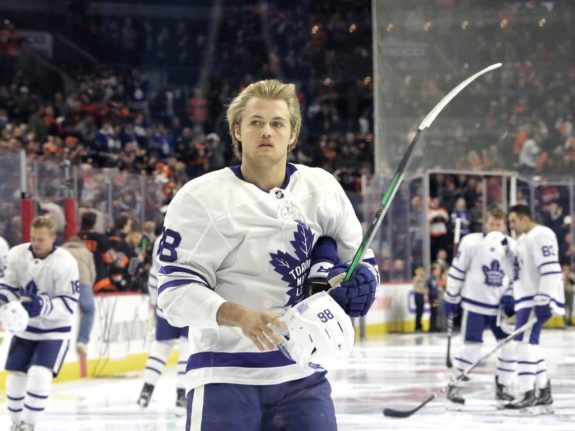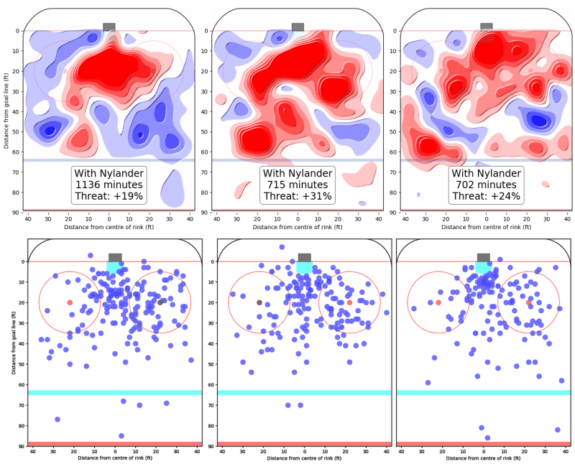
 Chris Faria
The Hockey Writers
Chris Faria
The Hockey Writers
17
Reads
0
Comments
Maple Leafs: Nylander’s Comeback Season Just the Beginning
Hockey is a results-driven business, and no one knows that better than Toronto Maple Leafs forward William Nylander.
After a lengthy contract stalemate and disappointing 2018-19 campaign with just 27 points in 54 games, members of the media and fanbase alike wrote Nylander off as an overpaid prima donna who would never live up to his six-year, $42 million contract. Despite general manager Kyle Dubas’ outward commitment to the Swedish winger, his name was casually tossed around in trade talks over the summer. (from ‘Maple Leafs GM Dubas defends Nylander, Gardiner,’ Brantford Expositor, 01/22/2019)

Nylander came to represent – at least to parts of the fanbase – everything that was wrong with this version of their Maple Leafs: he was (supposedly) too soft, too inconsistent, and too cool to get his nose dirty. The team was stacked on offence anyway, and that, they claimed, was why the 23-year-old could be shipped out for help elsewhere.
Isn’t it funny how much can change in just a few short months?
Having already tied his career high with 22 goals, Nylander has tallied 43 points in 49 games. He’s on pace to score 37 goals and 72 points, blowing his past plateau of 61 points out of the water. He’s finally becoming the player that he was meant and expected to be, which is why the Professional Hockey Writers’ Association voted him as the Comeback Player of the Year in their midseason awards.

Let’s take a look at how far Nylander has come since last year’s struggles, what’s driving his bounce-back season, and what we can expect from him over the rest of the season and beyond.
Nylander’s Struggles Were Overstated
One thing that seemed to slip through the cracks of mainstream media narratives last season was that Nylander was never actually as bad as his point totals might have suggested.
Related: William Nylander Is More Than His 2018-19 Season
After missing training camp and the first two months of the season, it was apparent that Nylander was not up to speed; he looked a step behind and out of game shape, often keeling over after his shifts. And that sluggishness made itself apparent on the score sheet as he collected just two assists through his first 11 games.
From Jan. 1 until the end of the season, though, Nylander found his footing, racking up 25 points in 43 games. Over that span, his 19 points at five-on-five tied him for 70th among forwards – a solid first-line scoring rate. Down the stretch, when regular season hockey gets tight as teams gear up for the playoffs, Nylander produced about as much as notable names like Patrice Bergeron (20), Brayden Point (20), Evgeni Malkin (19), Claude Giroux (19), and Mark Scheifele (19), among others.
In fact, if you look at the rate metrics from January onwards, Nylander’s five-on-five points-per-hour were more or less in line with his career averages. It was really just the power play where he faltered (though it didn’t help that he averaged just 1:51 per game on a relatively ineffective second unit).

It’s also worth noting that outside of pure point production, Nylander was one of the best play drivers on the Maple Leafs last season. Among NHL forwards, his 56 percent Corsi for ranked 23rd and his 54 percent expected goals for ranked 75th at five-on-five. That ultimately translated to some solid results for his team as they outscored opponents 33-27 when Nylander was on the ice.
While it’s easy to point fingers and talk about lack of effort, the real cause of Nylander’s subdued scoring was a suspiciously low individual and on-ice shooting percentage. At five-on-five, the Swede scored on just 5.31 percent of his shots while his on-ice shooting percentage dipped to a dismal 7.69 percent. A huge part of that, of course, was down to his linemates as he shared nearly all of his five-on-five ice time with lesser-skilled players like Connor Brown and Patrick Marleau. But when you consider that both he and his linemates shot over nine percent at five-on-five in his 185 games over the three previous seasons, it becomes clear that 2018-19 was bound to be an outlier.
That brings us to his breakout season in 2019-20.
2019-20: Same Process, Better Results
It’s clear that Nylander is on pace for his best season ever, but his production has been the result of his strong play-driving ability rather than a drastic change in his overall game. And that ability to drive shots, chances, and goals for his team has always been there for the crafty winger; it’s just that he’s now being rewarded more than ever before.

A couple interesting patterns stand out here. For one, Nylander’s individual high danger chances for per hour (iHDCF/60) and individual expected goals per hour (ixG/60) are essentially the same over the last two seasons. That goes against every narrative about his reluctance to get to the dirty areas around the net, and in fact, he scored less last season despite producing more dangerous chances than in the prior two seasons (just more proof of how unlucky he was).
Yes, Nylander is currently second in the league in terms of goals scored from the “home plate” area (he’s got 17), but his penchant for driving to the blue paint has been apparent for at least a couple of years now.

The second statistic of note is his current goal-scoring rate: Nylander is essentially doubling his career-average rate at five-on-five despite putting up similar underlying numbers to last season. That’s partially due to an increase in ice time and scoring-chance generation, but it’s also largely tied to a sizeable boost in shooting percentage (which is largely tied to luck).
While Nylander is currently scoring on 15.7 percent of his shots, we would probably expect that number to come back down to earth, more towards his career average of 11 percent. There’s probably been some genuine improvement in his scoring ability – I’ve always thought he had a great shot and just had to learn how to use it – but maintaining a 15 percent shooting rate likely isn’t sustainable given that Auston Matthews is only a career 15.9 percent shooter. If Nylander can consistently score on 12 or 13 percent of his shots while continuing to produce dangerous chances at an elite rate, though, he can certainly be a consistent 30-goal threat.
What’s Nylander’s Ceiling?
Nylander has taken huge strides forwards this season, leaving no doubt that he is an upper-echelon first-line player. But while the slick Swede has always been a fantastic driver at five-on-five, there is one more area where he can take another step to unlock his full potential: the power play.
Surprisingly, Nylander’s best power play performance came in his first full season (2016-17) where he tallied 26 power play points on a unit with Matthews. That was good for 13th in the league among forwards and by far the best on the Maple Leafs. He fell off to 12 power play points in 2017-18 and put up just six in his shortened 2018-19 season.
So far this season, he’s had a bit of a re-emergence with 12 points on the man advantage, placing him in the top-50 among forwards, though he’s still well behind teammates Mitch Marner, John Tavares, and Matthews in terms of both raw and rate production. However, it’s important to remember that Nylander has only been on the first unit since head coach Sheldon Keefe took over and essentially rearranged all of the team’s systems, so he’s still playing catch up in that regard.
He’s on pace for a respectable 20 power play points, which is pretty impressive given how few penalties the Maple Leafs draw. But if Nylander is going to become a premier offensive talent in the NHL, he’s going to have to take another step on the power play as that’s where skilled players really rack up points and pad their totals. And that shouldn’t be too hard for Nylander. After all, he’s proven his doubters wrong before.
Stats from http://naturalstattrick.com/
The post Maple Leafs: Nylander’s Comeback Season Just the Beginning appeared first on The Hockey Writers.
Popular Articles

















































 Blackhawks Chicago
Blackhawks Chicago Panthers Florida
Panthers Florida Penguins Pittsburgh
Penguins Pittsburgh Rangers New York
Rangers New York Avalanche Colorado
Avalanche Colorado Kings Los Angeles
Kings Los Angeles Maple Leafs Toronto
Maple Leafs Toronto Bruins Boston
Bruins Boston Capitals Washington
Capitals Washington Flames Calgary
Flames Calgary Oilers Edmonton
Oilers Edmonton Golden Knights Vegas
Golden Knights Vegas Senators Ottawa
Senators Ottawa Lightning Tampa Bay
Lightning Tampa Bay Flyers Philadelphia
Flyers Philadelphia Islanders New York
Islanders New York Sabres Buffalo
Sabres Buffalo Red Wings Detroit
Red Wings Detroit Devils New Jersey
Devils New Jersey Hurricanes Carolina
Hurricanes Carolina Blue Jackets Columbus
Blue Jackets Columbus Predators Nashville
Predators Nashville Stars Dallas
Stars Dallas Jets Winnipeg
Jets Winnipeg Wild Minnesota
Wild Minnesota Blues St. Louis
Blues St. Louis Mammoth Utah
Mammoth Utah Sharks San Jose
Sharks San Jose Ducks Anaheim
Ducks Anaheim Canucks Vancouver
Canucks Vancouver






